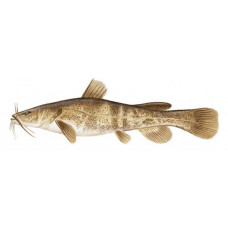Latin name
Pylodictus olivaris
Other names
Mud cat, muddy, shovelhead, shovelnose, yellow cat, appaloosa, goujon, johnnie cat, pied cat, Morgan cat.
Identification
The flathead catfish has a distinctive appearance and is not easily confused with any other species. It has a square rather than forked tail, a long body and a large flattened head. Medium to large specimens are more stooped, with a broad head and beady eyes. The distinctly flat oval eyes accentuate the flatness of the head, and the lower jaw accentuates this feature by protruding beyond the upper jaw. Compared to other species, the anal fin is shorter at the base and has 14 to 17 rays. Colour varies greatly from habitat to habitat, and sometimes within the same habitat, but is generally mottled with various shades of brown and yellow on the sides, tapering to a lighter or whitish mottling on the belly. Like other catfish, flatheads have heavy, sharp thoracic and dorsal spines and long mouth spines.
Distribution
Flatheads are found in the lower Great Lakes and the Mississippi, Missouri and Ohio river basins from southern North Dakota to western Pennsylvania and south to northern Mexico and the western tip of Florida. They are widely distributed within this range and have been successfully transplanted well beyond.
Habitat
This species mainly inhabits large bodies of water, especially reservoirs and their tributaries, but also large rivers and their tributaries. In rivers they prefer deep pools where the water flows slowly and hollows or pits such as those found in whirlpools and near bridge abutments. They are also often found in tailings ponds below dams. The habitat they choose often has a hard bottom, sometimes mixed with driftwood or wood. In large reservoirs they are usually found in deep water, often in old river beds, at the confluence of underwater channels and near the headwaters.
Size
Flathead catfish are a large and fairly fast-growing species, especially in the southern and warmer parts of their range. Most anglers encounter flathead catfish from a few pounds to 10-15 pounds. Fish to 20 pounds are not uncommon and fish to 50 pounds are possible in the best waters. Many state records are between 60 and 80 pounds, and the world record, set in Kansas in 1998, is 123 pounds. However, flathead catfish also grow larger, with a 122-pound specimen caught in Texas and individuals up to 139 pounds recorded in Arkansas. This species does not reach the maximum size of the blue catfish. The chances of catching a really big one are greater than the chances of catching a big blue catfish because the former species has a wider range and more large flatheads are available. Flatheads have been reported to reach 30 pounds in less than 10 years, and the largest specimens are believed to reach 20 to perhaps 30 years of age, although there is very little information on their absolute longevity.
Life history and Behavior
Flathead catfish spawn in spring or early summer when water temperatures are between 70° and 80°F. Nests are built by one or both parents, usually in crevices and burrows under logs and trees and in undercut banks. Like other catfish, they prefer secluded and dark places and the nest site is often a log, tree or other object. The male guards and incubates the eggs and then guards the young until they disperse.
Food and feeding habits
Like its brethren, the flathead catfish is omnivorous and opportunistic, consuming a wide variety of available food. Flathead catfish are mainly bottom feeders and consume insects, crayfish, molluscs and a variety of small fish. Adults will consume larger prey, including some land animals that have the misfortune to be in the water. Live fish are a popular bait for Flatheads, more so than other catfish species, as these fish are reluctant to eat old and smelly bait. Although not exclusively nocturnal, flatheads are more active at night and may spend the day resting in deep water or under cover. At night they may move to shallow water and feed at various depths.
Reproduction
No information
| Classification | |
| Phylum | Chordata |
| Class | Actinopterygii |
| Squad | Siluriformes |
| Family | Ictaluridae |
| Genus | Pylodictis |
| Species | P. olivaris |
| Features | |
| Conservation status | Least Concern |
| Habitat | Bottom |
| Life span, years | 28 |
| Maximum body weight, kg | 63.45 |
| Maximum length, cm | 175 |
| Sailing speed, m/s | No information |
| Threat to people | Edible |
| Way of eating | Predator |


